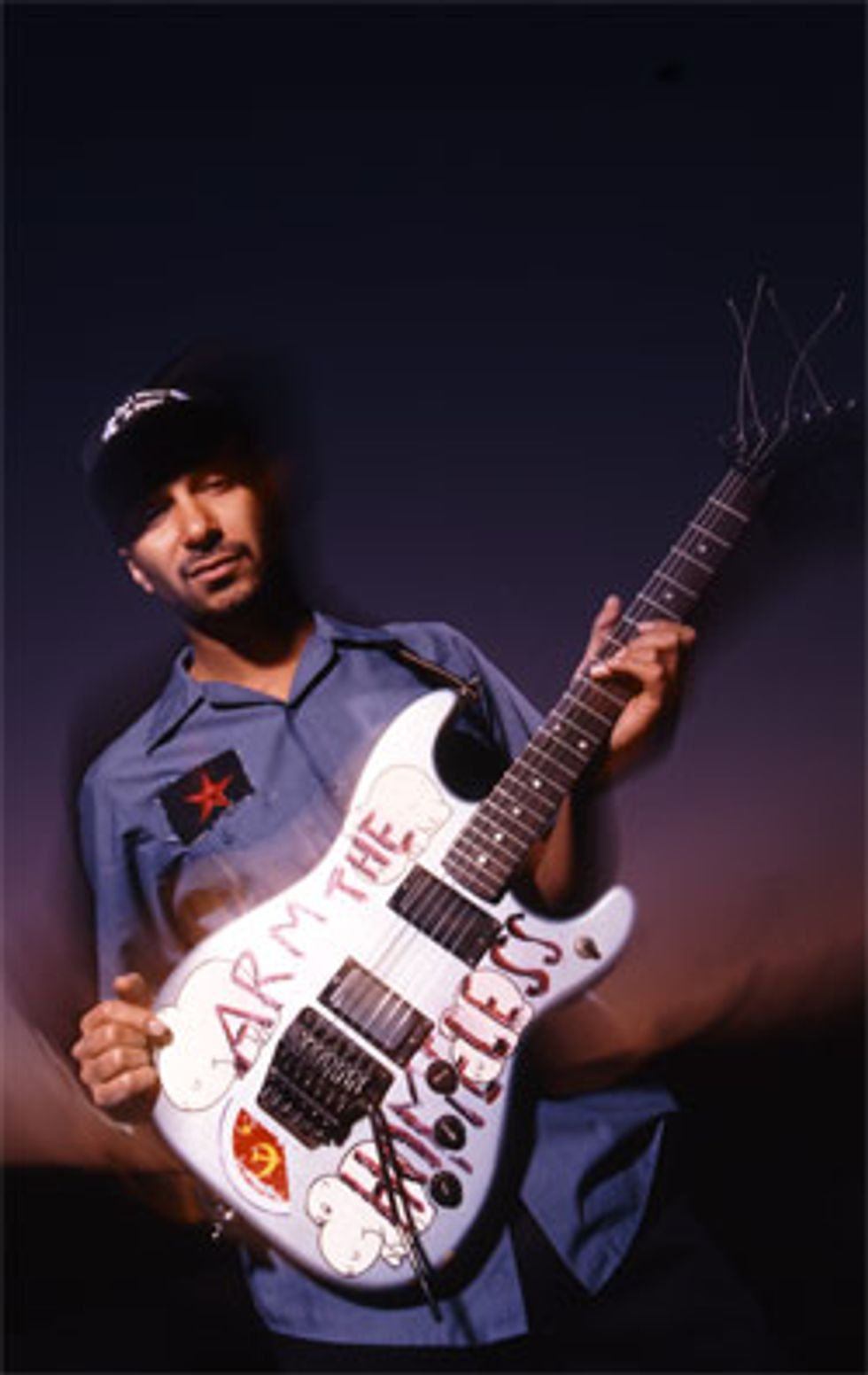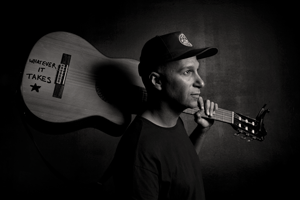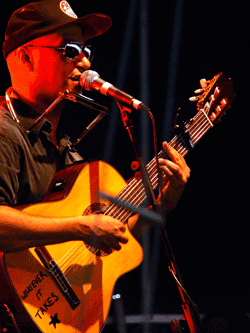Tom Morello has made a name for himself with huge acts Rage Against the Machine and Audioslave. Now, he’s touring solo as The Nightwatchman, his political and artistic outlet. We talk about how he covers all his bases with a stripped-down rig.
|  |
Tom has not only tweaked and dialed endlessly, but also approached the guitar without blinders, which has allowed him to produce a wide spectrum of sounds with such seemingly limited tools. He’s used a wrench and a pencil across his strings [“People of the Sun”], [“Revolver”], tapped the bridge with his cable[“Testify” and “Bullet in the Head”] and often toggled quickly between his pickups to get that trademark DJ scratching sound.
However, since 2002, he’s gone back to the basics. Through his acoustic alter-ego, The Nightwatchman, Tom has satisfied a personal thirst that Audioslave couldn’t quench—politically charged lyrics. For a guy who graduated from Harvard with a degree in Political Science and at one point in his life practiced guitar for eight hours a day, every day, there really isn’t another choice.
We recently had the chance to talk with Tom, and he told us about guitars, effects, that “moment” and what it’s like being a life-long Chicago Cubs fan.
What spawned your conception of your alter ego, The Nightwatchman?
It was spawned to act as an antidote for the arena rock of Audioslave. I greatly enjoyed playing and being in that band, but there was one itch that it didn’t scratch. The worldview of that band and my worldview were two very different things. So, I just began writing songs on my own with really no agenda other than to have an artistic outlet.
How did you start playing solo gigs without drawing too much attention?
I began playing at open mic nights in 2002, sometimes even on nights off during the Audioslave arena tours. I’d go and sign up as The Nightwatchman because I didn’t want people screaming out “Bulls on Parade.” I just wanted to play my songs. Even at those very early shows, when I was a fledgling singer/songwriter, it felt like that might be what I was put here to do.
Every time I write a song, record a song or step on any stage, I play as if everyone’s soul in the room is at stake. I feel if you’re honest in your music and you’re able to weave your convictions and your point of view in the music you’re making, then every show you play matters, in that regard. The connection with the crowd and my belief in the material was pretty strong, even at the start. However, I’ve had to win over every crowd that I’ve performed in front of.

On your first solo release One Man Revolution, you didn’t have any backing music. What provoked you to add the full-band on your second solo release, The Fabled City?
Well, I mean I felt much more comfortable having sort of established what this thing is on the One Man Revolution, I felt much more relaxed bridging the gap between my life as a rock musician and my life as an acoustic singer/songwriter. Also, I was more at ease fleshing out arrangements, but keeping the integrity of the acoustic thing intact.
However, I wanted to bring in some of my rock music roots and elements into this project. Even though the record has electric instrumentation, I’m still just using an acoustic guitar. I brought some of my electric
guitar effects pedals, added some riff rock, soloing, and even introduced my Django Reinhardt impersonation, which is evident in the song “The Lights Are On In Spidertown.”
I’ve recently read something that described your live show as the first half being “played with nylon strings, three chords and the truth, while the second half is filled with rocking action not even seen in Rage or Audioslave.” With a statement like that, what can fans expect in upcoming gigs?
The template for this tour is half Dylan and half Hendrix. There’s going to be some solo acoustic playing and then I’m bringing on a band called the Freedom Fighter Orchestra and I’m just going to unleash the electric guitar in a way that I’ve never done on a tour before. I like the idea of combining all the elements of my playing and not restricting any of it. Even in Rage and Audioslave, while I love playing electric guitar in those bands, the solos are contained to eight bars within those three and half minute songs. There’ll be no such constraints on this upcoming tour. We’ve already played a few shows and it’s been really exciting.
What were some of the guitar effects used on The Fabled City?
There’s an octave pedal, a DigiTech Whammy WH-1 (original), an MXR Distortion Plus on “Whatever It Takes” and basically I just had my usual pedalboard sitting there. Also Brendan O’Brien, the producer of the record, had a lot of stompboxes lying around the studio. I do some slide guitar and of course I incorporate some echo and delay; it’s about not feeling restricted in any way to the bare bones acoustic.
Getting back to your electric roots—starting with your first band Lock Up in the late-eighties and then eventuallyhitting mainstream success with Rage Against the Machine in the early-nineties— what pushed you in the direction of being such an effects master?
Well, to tell you the truth, I’m not really using different effects on every album or each tour, but the case is that I’ve used the same pedalboard and effects—which aren’t that many—since the start of RATM. I use the same Marshall JCM 800 2205 50-watt head, which goes through a Peavey 4x12 cabinet that I’ve had for almost 20 years. As it goes for effects, I primarily only use four pedals: my DigiTech Whammy WH-1, Jim Dunlop Crybaby Wah, Boss DD-2 Digital Delay and DOD Electronics FX40B boost for solos. That’s basically it, which is far fewer effects than most guitarists. However, I’m always trying to find creative
and new ways to use these same pedals.
What pushed me into that direction of playing style was the fact that there was a point that I practiced playing guitar eight hours a day, every day and amassed a pretty solid technique on the instrument. But,
I sounded like every other guitar player that could play shredding solos. There was one particular gig early on with RATM that sticks out in my mind. We were opening up for two cover bands at a college out in the San Fernando Valley and the one band had two guitarists and the other only had one. All three of these guys were amazing, shred-fest musicians and I thought, “If there are three shred guitarists on this shitty college campus stage, there doesn’t need to be a fourth.” I knew I had to find my own voice on the instrument. That is when it dawned on me that the guitar players that I loved like Page, Holdsworth and Andy Gill of Gang of Four, all had their own unique voice on the guitar. I realized at that show that I wasn’t just going to be the guitarist of Rage, but the DJ.
 What guitars do you mainly use live and for recording?
What guitars do you mainly use live and for recording? I’ve used a lot, but I only have two main guitars. One is sort of a Frankenstein guitar, which is called “Arm the Homeless,” and I have been customizing piece by piece for years. It features a Kramer neck, EMG pickups, Floyd Rose Tremolo and other knob and switch modifications. The other one is my stock 1982 Fender Telecaster: “Sendero Luminoso.”
At the time I was writing songs in drop-D tuning and my only other guitar had a locking nut so I couldn’t do the tuning. My roommate needed a Marshall head and I had an extra, so I traded him the head for that ’82 Tele. And that’s how I got my main guitars [laughs]—by piecing one together and trading equipment for the other. It wasn’t based on research and development with experiments, but just the guitars that fell into my hands. I just decided to stop worrying so much about seeking some magical guitar and tone, but instead using what I had to write music effectively and incorporate a unique tone that I did have.
When doing covers like Dylan’s “Maggie’s Farm,” Springsteen’s “The Ghost of Tom Joad” and Cypress Hill’s “How I Could Just Kill A Man,” for the Renegades album, how did you balance lending your own touch and doing justice to the originals?
All of the music, except for maybe one or two songs, was written pretty independently of any lyrical content. So, we basically wrote songs with strong riffs and good arrangements that we thought were rocking and Zach decided what he was going to sing on. The riffs on “Maggie’s Farm” were written as a cool Rage Against the Machine riff or jam and it later had the Dylan lyrics applied to it. It was about writing and developing the music and tone that was original and reflected our band, but still enabling the lyrics of the original artist to shine through—that’s the tough part of doing cover songs.
What attracted you to the Marshall JMC 800 head and Peavey cabinet combo?
The reason behind that was I had to record a demo for my band on the weekend and all my gear got stolen out of my van. I only had a couple days to replace the gear and I went to the local music store in Hollywood. I went in there and they only had one Peavey cabinet, so I bought that. They had two heads, a Marshall and something else. I was suspicious of the something else so I bought the Marshall and that was it. It worked on that demo and I’ve loved the sound from that combo to this day—no magical rhyme or reason, but it has worked out for me quite well.
For years I was seeking out this miraculous tone and I was banging my head against the wall trying to get all this horrible rack gear—which I thought made my sound worse—and cab/head combinations, but nothing really worked. Finally, I went back to the Marshall head and Peavey cabinet. I was at rehearsal and I spent at least four hours tweaking knobs just a hair this way and a hair that way to a point where I felt the sound was reasonable, and I marked those settings. This happened in ’88 or ‘89 and those markings are the same ones I’ve used to this day. They are the same markings/settings I used at every show and every record I’ve ever made.
If you were sent to a desert island—that happened to have electricity—with one guitar and one effect, which would they be?
Wow, that’s a very good question. If I had to choose just one guitar and it had to be an electric, I’d have to say the “Arm the Homeless” Frankenstein-guitar because we’ve been friends for a long time. And if I could only pick one effect pedal… there is quite a variety of sonic flavors, I’d probably choose an echo-style pedal because I think that would sound best since I’d be mournful out there all alone on the desert isle.
I know that one of your other passions, dating back to your Harvard days, is politics. Obviously, this can be polarizing in music; how do you react to people who might say you should just be a guitar player?
Well, I mean I’m a guitar player who lives in the United States. In the United States, we have what we call the Bill of Rights, which includes the freedom of speech. So, first of all, I’d remind them that we have that freedom and if they prefer a totalitarian society where musicians aren’t allowed to speak on political matters, they need to find to another country because it’s not this one. And don’t get me wrong, these types of criticisms only come from people who have dissenting opinions and thoughts. The argument that musicians need to be just musicians not fully express themselves usually stops once they find someone who agrees with them. Whether it’s an actor like Ronald Reagan or Arnold Schwarzenegger or a conservative artist, we should all agree that we should be able to speak our mind freely, even if we disagree on politics, war or even music.
Another passion that I happen to share is a never-ending admiration for the Cubs. With another playoff sweep under their belt, what’s your take on being a Cubs fan?
As Cubs fan know, we keep finding out that there is no basement. You think you’re at the bottom, but the elevator keeps going down. It’s incredible. This year, I was cynical from the start while everyone was saying “This is the best Cubs team ever.” That doesn’t matter—we are the Cubs. If you give us the greatest team ever assembled, we’ll find a way to screw it up.
| ||||
I equate it to having a vengeful girlfriend who builds you up with all that love during the regular season, then come playoff time, she kicks you in the balls and takes your rent money, but you just can’t find it in your heart to leave her.
Exactly man, it is like a train-wreck of a relationship that you just don’t know how to end. Every time she lets you down, you give her one last chance.
What can we expect from Tom Morello in 2009?
Well, I know for sure that I’ll be doing a lot of Nightwatchman dates in the coming year and continuing the Axis of Justice organization [axisofjustice.org] that I run with Serj Tankian [System of a Down]. I got a pretty large cache of Nightwatchman songs that I haven’t released yet so I’ll definitely continue writing and recording. Also, I had a great time playing Rage Against the Machine shows over the course of the year and half and I have no doubt that we’ll continue to do more of those in the future.
From Your Site Articles
